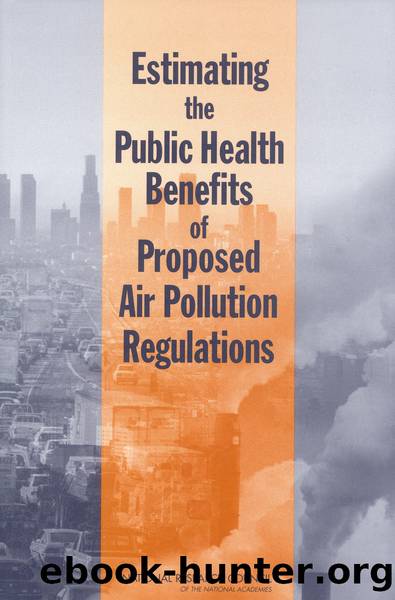Estimating The Public Health Benefits Of Proposed Air Pollution Regulations by National Research Council of the National Academies

Author:National Research Council of the National Academies
Language: eng
Format: epub
Tags: Health and Medicine: Public Health and Prevention
Publisher: NATIONAL ACADEMY PRESS
Published: 2002-10-31T00:00:00+00:00
HEALTH OUTCOMES
Air pollution may give rise to health outcomes depending on specific pollutants and their concentration or exposure levels. The appropriate selection and interpretation of health outcomes is integral to any assessment of health benefits. Overall, the health effects of air pollution can be described on three levels. The first level is the way that air pollution adversely affects biochemical, physiological, and pathological mechanisms. The second level concerns the way these mechanisms translate into recognized health effects (symptoms, impairment of activity, pain, or death). The third level involves translation of health effects into public health terms (incidence, prevalence, and mortality rates).
The pathophysiological effects will, if sufficiently severe, become manifest in individuals as illness (symptoms, impairment, pain, disability, death) and be attributed to certain clinical diagnoses, such as asthma or pneumonia. These effects may be associated with the use of medical services or medications. However, the health effects of many air pollutants, such as PM and ozone, lack specificity. In other words, the manifestations of these air pollutants may have other causes and cannot be understood independently from risk factors with the same outcomes.
The primary health effects resulting from air pollution have been observed in the respiratory and cardiovascular systems (ATS 1996, 2000). There is also growing evidence that air pollution exposure may cause reproductive and developmental effects (Brunekreef 1999). Short-term effects are typically minor and reversible at the levels of air pollution generally encountered in the United States, unless there is a preexisting condition that has already reduced the reserve or adaptability of the individual (ATS 1996, 2000). For example, certain air pollutants may cause a transient mild cough or eye irritation in a healthy person with plenty of functional reserve. However, for an older person who has advanced chronic respiratory disease and who is acutely ill with a respiratory infection, exposure to air pollution might result in death or some other clinically observable outcome, such as hospital admission. If the person would die soon regardless of the exposure to air pollution, the additional effect of the air pollution could be small in terms of life-years lost.1 On the other hand, if the person would otherwise recover from the respiratory infection, the loss of life-years could be appreciable. Regarding the development of chronic disease, such as chronic obstructive pulmonary disease or asthma, the effects of air pollution are likely to act together with other risk factors, such as exposure to environmental tobacco smoke.
1This scenario is referred to as short-term mortality displacement or harvesting.
Download
This site does not store any files on its server. We only index and link to content provided by other sites. Please contact the content providers to delete copyright contents if any and email us, we'll remove relevant links or contents immediately.
| Automotive | Engineering |
| Transportation |
Whiskies Galore by Ian Buxton(41713)
Introduction to Aircraft Design (Cambridge Aerospace Series) by John P. Fielding(33011)
Small Unmanned Fixed-wing Aircraft Design by Andrew J. Keane Andras Sobester James P. Scanlan & András Sóbester & James P. Scanlan(32678)
Craft Beer for the Homebrewer by Michael Agnew(18076)
Turbulence by E. J. Noyes(7888)
The Complete Stick Figure Physics Tutorials by Allen Sarah(7258)
Kaplan MCAT General Chemistry Review by Kaplan(6814)
The Thirst by Nesbo Jo(6748)
Bad Blood by John Carreyrou(6468)
Modelling of Convective Heat and Mass Transfer in Rotating Flows by Igor V. Shevchuk(6349)
Learning SQL by Alan Beaulieu(6153)
Weapons of Math Destruction by Cathy O'Neil(6077)
Man-made Catastrophes and Risk Information Concealment by Dmitry Chernov & Didier Sornette(5870)
Digital Minimalism by Cal Newport;(5576)
Life 3.0: Being Human in the Age of Artificial Intelligence by Tegmark Max(5399)
iGen by Jean M. Twenge(5300)
Secrets of Antigravity Propulsion: Tesla, UFOs, and Classified Aerospace Technology by Ph.D. Paul A. Laviolette(5232)
Design of Trajectory Optimization Approach for Space Maneuver Vehicle Skip Entry Problems by Runqi Chai & Al Savvaris & Antonios Tsourdos & Senchun Chai(4949)
Electronic Devices & Circuits by Jacob Millman & Christos C. Halkias(4859)
